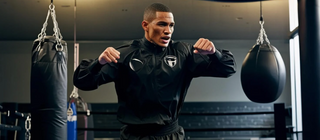How to learn to jump rope-seriously!
If you practice combat sports, you have probably been using rope for a long time to warm up or improve physical endurance. If you've wondered at least once whether you're using it the right way, you'll find the answers you're looking for in this article!
Let's start with a premise: training with the rope, as simple and basic as it may seem, is not for everyone. Two categories of people should avoid: those who are overweight, because it would overstress the joints and back; those who have recently suffered from pathologies such as fasciitis and tendonitis in the feet, to avoid relapse.
If you do not fall into one of the above categories pull out the rope and get ready!
Rope is an excellent means of warm-up both in the gym and pre-race, because thanks to the continuous rapid contractions it adequately activates the muscles, providing explosiveness and quickness to the legs.
We recommend incorporating rope jumping work between the general warm-up phase (during which you do some mild running, dynamic stretching, sprints and circles) and the specific warm-up phase, (during which you perform techniques at the strikers or with teammates).
Entering 10 to 15 minutes of rope activity between these two phases on the one hand you will be sure to raise your body temperature adequately, and on the other hand you will have called up speed and explosiveness on your legs and feet before performing techniques that require the most from this point of view.
If you've been using rope for your workouts recently or don't use it frequently, start with a bit of a warm-up: a few minutes of gentle running in place, skipping and kicking at a low frequency is sufficient to prepare the joints (especially ankles, knees and back) for the rope workout.
NB. Be sure to wear comfortable footwear, especially if you are jumping on hard surfaces such as asphalt or concrete; however, if you are on the tatami you can safely train barefoot.
Shall we get started?
One more moment: we must first find the right length calculated on your height: to do this put one foot in the middle of the rope, and lift the handles: they should be about armpit height, no more.
3.. 2... 1... go!
Start jumping, trying to leave only one/two inches between you and the floor, just enough to get the rope under your feet; remember that only the forefeet should make contact with the ground.
As you spin the rope keep your elbows close to your hips; try to start the movement from your wrist and forearm, not your shoulders.
Once you have mastered the basic step you can aim for variations:
- switch from one foot to the other, as if it were a run in place
- jumping left and right while keeping your feet together
- jumping back and forth while keeping feet together
- draw a kind of "X" +" passing
- open and close the feet sideways
- bring one foot forward and one foot back alternately
- do two consecutive bounces per foot
- double unders, that is, with one bounce do two consecutive turns of the rope
- cross your hands in front
How much time to devote to training
Initially you can work by doing 30-second rounds with 15-second recovery. Try to progressively increase the work time to 1 minute while keeping the recovery the same. The goal can be to work for the duration of a combat round, so 2 or 3 minutes depending on your specialty.
The small size and light weight of this tool ensure its easy portability, making it a great workout companion even when you will be away from home, and want to conduct a quick 20-30 minute workout.
You can thus set up a "out-of-town" workout (after you have already gained some confidence in jumping rope):
+ 5-10 minutes of pre-activation: some running in place, skip and kick, some jumping jacks (opening and closing the legs sideways while coordinating the arms going up and then back to the hips). We recommend. 30 seconds of work for each exercise. After that, some dynamic stretching of the various joints (lunges, circles, flexion-extension, etc.), especially back, knees and ankles
+ 15-20' seconds of middle phase that you can conduct in two ways:
- 5-7 rounds of 2-3 minutes interspersed with 1 minute of recovery; during the work time you can indulge in the various types of jumping
- 2-3 shots of 2-3 minutes followed by 1-2 circuits "Tabata", which is a training protocol that involves 20 seconds of very high intensity exercise followed by 10 seconds of recovery repeated 8 times. Since this is a very short protocol (4 total minutes of work) during the 20 seconds you will have to give it your all, keeping a very high pace, such as performing only double unders, or the high knee skip;
+ Before finishing the workout, 5 minutes of abs during which you can perform 2-3 sets of 15-20 repetitions of your favorite exercises
+ The last 10 minutes devote them to the stretching for both the lower limbs and the back







